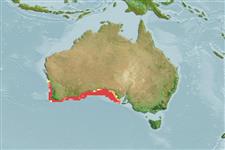Elasmobranchii (tubarões e raias) (sharks and rays) >
Rajiformes (Skates and rays) >
Arhynchobatidae (Softnose skates)
Etymology: Irolita: From Irolita, a princess in love with prince Parcinus. The beauty of the princess was worthly the world´s admiration. Mythology.
Eponymy: Irolita is a beautiful female character in a fairy story written by Marie-Catherine Le Jumel de Barneville, Baroness d’Aulnoy (1650–1705). The reasoning behind this choice of name is not explained by the author. Edgar Ravenswood Waite (1866–1928) was an English-born Australian zoologist and ichthyologist. [...] (Ref. 128868), visit book page.
Environment: milieu / climate zone / depth range / distribution range
Ecologia
marinhas demersal; intervalo de profundidade 50 - 200 m (Ref. 6871). Temperate; 29°S - 36°S, 113°E - 136°E (Ref. 114953)
Eastern Indian Ocean: south-western Australia.
Comprimento de primeira maturação / Tamanho / Peso / Idade
Maturity: Lm ?, range 46 - ? cm
Max length : 52.0 cm TL macho/indeterminado; (Ref. 6871)
Occur over soft bottoms of the continental shelf (Ref. 7300, 75154). Oviparous. Distinct pairing with embrace. Young may tend to follow large objects, such as their mother (Ref. 205). Eggs are oblong capsules with stiff pointed horns at the corners deposited in sandy or muddy flats (Ref. 205). Egg capsules are 5.1-7.6 cm long and 3.2-3.8 cm wide (Ref. 41308). Males reaches maturity at ca. 46 cm TL. Occassionally caught as bycatch and typically discarded (Ref. 114953).
Ciclo de vida ou comportamento de acasalamento
Maturidade | Reprodução | Desova | Ovos | Fecundidade | Larvas
Oviparous, paired eggs are laid. Embryos feed solely on yolk (Ref. 50449). Distinct pairing with embrace. Young may tend to follow large objects, such as their mother (Ref. 205).
McEachran, J.D. and K.A. Dunn, 1998. Phylogenetic analysis of skates, a morphologically conservative clade of elasmobranchs (Chondrichthyes: Rajidae). Copeia 1998(2):271-290. (Ref. 27314)
Status na Lista Vermelha da UICN (Ref. 130435: Version 2024-2)
Ameaça para os humanos
Harmless
Uso pelos humanos
Ferramentas
Relatórios especiais
Baixar XML
Fontes da internet
Estimates based on models
Preferred temperature (Ref.
123201): 15 - 18.5, mean 16.6 °C (based on 27 cells).
Índice de diversidade filogenética (Ref.
82804): PD
50 = 0.7500 [Uniqueness, from 0.5 = low to 2.0 = high].
Bayesian length-weight: a=0.00562 (0.00288 - 0.01097), b=3.11 (2.94 - 3.28), in cm total length, based on LWR estimates for this (Sub)family-body shape (Ref.
93245).
Nível Trófico (Ref.
69278): 3.8 ±0.7 se; based on size and trophs of closest relatives
Resiliência (Ref.
120179): Baixo, tempo mínimo de duplicação da população 4,5 - 14 anos (Fec assumed to be <100).
Fishing Vulnerability (Ref.
59153): Moderate vulnerability (41 of 100).
